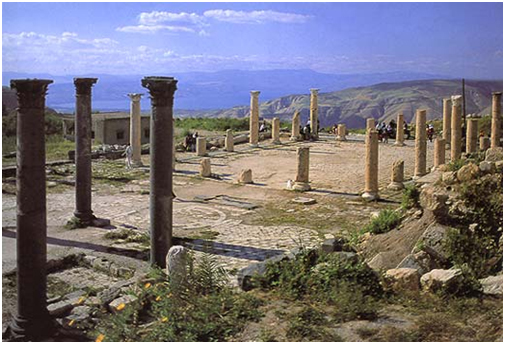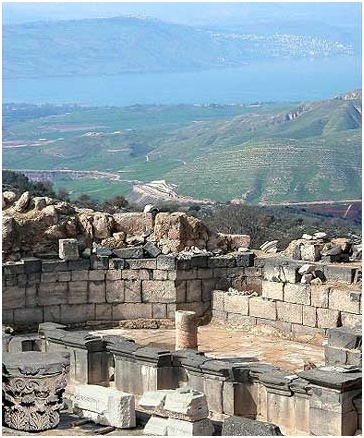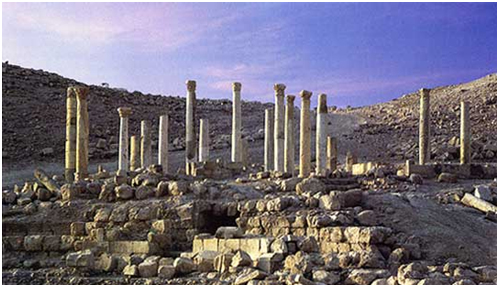The Decapolis
The Decapolis (meaning ten cities in Greek) was a ten-city Greco-Roman federation, or league, occupying all of Bashan and Gilead in northeastern Palestine and is mentioned three times in the New Testament. The territory was contiguous except for Damascus which some believe to have been an honorary member. Eusebius records it as the region around Hippos, Pella, and Gadara.
Created under Pompey the Great, about 64-63 BC as part of his eastern settlement, the league provided a formidable means of defense on the eastern frontier of the empire. Such leagues existed in other parts of the Roman Empire for purposes of trade and mutual protection.
According to Pliny the Elder (23-79 AD) the cities were:
1. Philadelphia (Amman, ancient Rabbath-Ammon),
2. Gerasa (Jerash),
3. Gadara (Umm Qais),
4. Pella (Tabaqat Fahl),
5. Dion (Adun, ancient Capitolias),
6. Raphana (Abila),
7. Damascus,
8. Kanatha (Qanawat),
9. Hippos (Susieh)
10. Scythopolis “city of the Scythians” (Bet She’an); the only one of the ten cities on the west of Jordan.
Each city was a free-state (polis) whose territory included numerous small villages and rural settlements, endowed with certain privileges. The Decapolis dominated trade routes in the region bringing about prosperity and funding for public art and monumental Greco-Roman architecture such as the one found in Gerasa.
Fertile soil and temperate climate encouraged the practice of intensive agriculture throughout the region. The presence of a significant Greek population, who settled in the region at the time of Alexander the Great and the Seleucids, is consistent with there being swine kept by the people of the Decapolis.
Gadara (Umm Qais)
Umm Qais is situated 110 km north of Amman on a broad promontory 378 meters above sea level with a magnificent view over the Yarmouk River, the Golan Heights, and Lake Tiberias. The town was known as Gadara, one of the most brilliant ancient Greco-Roman cities of the Decapolis; and according to the Bible, the place where Jesus (pbuh) cast out the Devil from two demoniacs into a herd of pigs (Mathew 8:28-34).
Gadara was strategically situated, laced by a number of key trading routes connecting Syria and Palestine. It was blessed with fertile soil and abundant rainwater. This town also flourished intellectually in the reign of Augustus and became distinguished for its cosmopolitan atmosphere, university’s scholars, attracting writers, artists, philosophers and poets, the likes of satirist Menippos (2nd half of the 3rd century BC), the poet and collector of epigrams Meleagros, and the rhetorician Theodoros (14-37 AD).
Archaeological surveys indicate that Gadara was occupied as early as the 7th century BC. The Greek historian, Polybius, described the region as being under Ptolemaic control at the time. The Seleucid ruler Antiochus III conquered it in 218 BC, naming the city Antiochia and Seleucia. In 63 BC, Pompey liberated Gadara and joined it to the Decapolis. Soon after, the fortunes of Gadara improved rapidly and building was undertaken on a large scale, carried out for the love of Pompey’s freed man Demetrius, who had been born there.
During these early years of Roman rule, the Nabataeans (with their capital in Petra), controlled the trade routes as far north as Damascus. Unhappy with the competition, Mark Anthony dispatched King Herod the Great to weaken the Nabataeans, who finally gave up their northern interest in 31 BC. In appreciation for his efforts, Rome rewarded Herod with Gadara.
The city reached its peak of prosperity in the 2nd century AD. New colonnaded streets, temples, theaters and baths sprouted. Meleagros compared Gadara with Athens, which testifies to the city’s status as a creative center of Hellenism in the ancient Near East. Christianity spread slowly among the inhabitants of Gadara. Starting from the 4th century, its bishop attended the ecclesiastical councils of Nicaea, Chaleedon and Ephesos. Despite his attendance, the city was no longer a seat of learning.
During the 6th century, decline set in and in 636 AD a decisive military clash between Byzantines and Arab Muslims took place not far from Gadara. Umm Qais’ charm still lingers today. A large portion of the western Roman Theater has survived history’s upheavals. Vaulted passageway supports its rows of seats, built of hard basalt stones. A row of elaborately carved seats for dignitaries stand near the orchestra, and in the center was a large headless white marble statue of Tyche, goddess of fortune and of the city, now displayed at the local museum.
Pella (Tabaqat Fahl)
Magnificently set in a fold of the hills that rise from the Jordan Valley 78 km north of Amman, Pella, known in Arabic as Tabaqat Fahl, is a favorite for archaeologists as being exceptionally rich in antiquities. It is perfectly situated, as it is next to a spring which issues into a small river never running dry. The tell itself seems to have been continuously occupied since Neolithic times for some flints from this period have been found there; and some recent finds 2 km north of the tell, even date to Paleolithic times, around 100,000 years ago.
Besides the excavated ruins from the Greco-Roman period, including an Odeon (theater) built in a curve of the hillside, Pella offers visitors the opportunity to see several artifacts such as Chalcolithic settlement from the 4th millennium BC, the remains of Bronze and Iron Ages walled cities, Byzantine churches and houses, an Early Islamic residential quarter, and a small medieval mosque.
The first literary reference to the city is from the 19th century BC when it is mentioned in Egyptian texts as Pihilum, or Pehel. It was a flourishing trade center, with links with Syria and Cyprus as well as Egypt. On the division of Alexander’s Empire, its name was changed to Pella, either in honor of Alexander’s birthplace, or as a Hellenisation of Pihilum, or both.
It changed hands between the Ptolemies and Seleucids, and was sacked by the Hasmonean Alexander Jannaeus. After Pompey’s conquest in 63 BC its prosperity increased further. The Byzantine era saw a revitalization of Pella, as trade routes strengthened and local industries developed. After the 7th century Arab conquest, Pella continued as an Umayyad city for over 100 years, and some superb pottery remains of that time have been found.
Unfortunately, like so many places in Jordan, the city was destroyed by the terrible earthquake of 747 AD. The site continued to be occupied during the Abbasid and Mamluk periods, but it was a much smaller and more rural community. There was still a mud-brick village on the tell until 1970, but it was bombed in an Israeli strike across the border.
Dion (Adun)
Dion (Adun) or ancient Capitolias is located on the site of the village of Beit Ras, astride the road north from Irbid. There are scattered architectural pieces that can be seen, some tombs, vaults, cisterns and traces of foundation walls, but no major standing structure.
Raphana (Abila)
Abila or Ancient Raphana lies slightly northeast of the modern city of Irbid, not far from Umm Qais. The largest site is located amidst verdant agricultural fields at the modern Ain Quweilbeh spring, with Roman temples, Byzantine churches and early mosques lying amidst olive groves and wheat fields.
Excavations indicate that the site was inhabited more than 5000 years ago in the early Bronze Age, and appears to have been continually used by man since then. Several of its ancient structures have been excavated including aqueducts, tombs, gates and public buildings.



